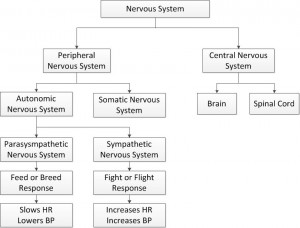Divisions of the Nervous System
The nervous system is responsible for transmitting and receiving electrical and chemical signals (messages) within the body. Each division of the nervous system plays a vital part in the functioning of the human body. The nervous system can also be considered the human body’s communication network. The nervous system sends messages through afferent neurons, efferent neurons and interneurons.
An afferent neuron pathway describes neurons (messengers) that send signals from the peripheral nervous system (arms and legs) through to the spinal cord and onto the cerebral cortex or command center within the brain. Efferent neuron pathways send messages from the cerebral cortex to the muscles and various organs in the body to achieve a desired response.
The following describes the actions of the afferent, interneuron and efferent responses to an event:
When a person places their hand on a hot frying pan causing the hand to burn afferent neurons send a message up the persons arm through to the spinal cord that something has gone wrong. At the spinal cord, interneurons (which act between the afferent and efferent neurons) identify that an immediate action is required resulting in a reflex arc (immediate action). Through this pathway, interneurons send a message via the efferent neurons to cause the muscles of the hand to move away from the frying pan.
Within the Nervous System there are two main areas, these include: The Central Nervous System and the Peripheral Nervous System.
The Central Nervous System includes the brain and the spinal cord. These two organs control many of the functions of the human body. The brain is the command center for the body. The brain stem (where the brain meets the spinal cord) controls many vital functions required to control life, such as: heart rate and diaphragm movement for respiration. The spinal cord is the main hub of communication signals, in which all peripheral afferent and efferent messages are transmitted.
The Peripheral Nervous System controls the messages to and from the brain and peripheries. The Peripheral Nervous System can further broken down into the Autonomic and the Somatic Nervous System.
The Somatic Nervous System is also identified as the Voluntary Nervous System, in which the person can transmit controlled messages from the Brain to the peripheries in order to control movement.
An example of the Somatic Nervous System includes: the Brain sending the message to the legs to move its arms. This causes the Somatic Nervous System to transmit a message through the peripheries through to the muscles in the arm to stimulate contraction and skeletal movement.
The Peripheral Nervous System is also called the Involuntary Nervous System and allows the brain to produce involuntary messages to cause changes within the body. The Peripheral Nervous System can be further broken into the Sympathetic and the Parasympathetic Nervous System.
The Sympathetic Nervous System causes the body to produce the “Fight or Flight Response,” in which adrenal responses such as a release of adrenaline and nor-adrenaline, cause an increase in heart rate, blood pressure, dilation of bronchioles and enhanced force of contraction of muscles within the body. This allows the human body to respond to an emergency.
An example of the Sympathetic Nervous includes: the response to a person holding a knife up to you and asking for your wallet, this results in the release of adrenal responses, which allows the person to have the best physiological ability to fight the mugger, or run from the mugger.
The Parasympathetic Nervous System is also known as the “Feed or Breed Response” and focusses on slowing the main systems of the body to aid in feeding and breeding, this includes, slowing the heart rate, lowering blood pressure, and slowing the motility of the gastro-intestinal tract (GIT).
An example of the Parasympathetic Nervous System would include: the circadian rhythm, which causes a slowing of the heart rate and a relaxation of muscles which allow a person to sleep.
This is a diagram of the basic divisions of the Nervous System.

